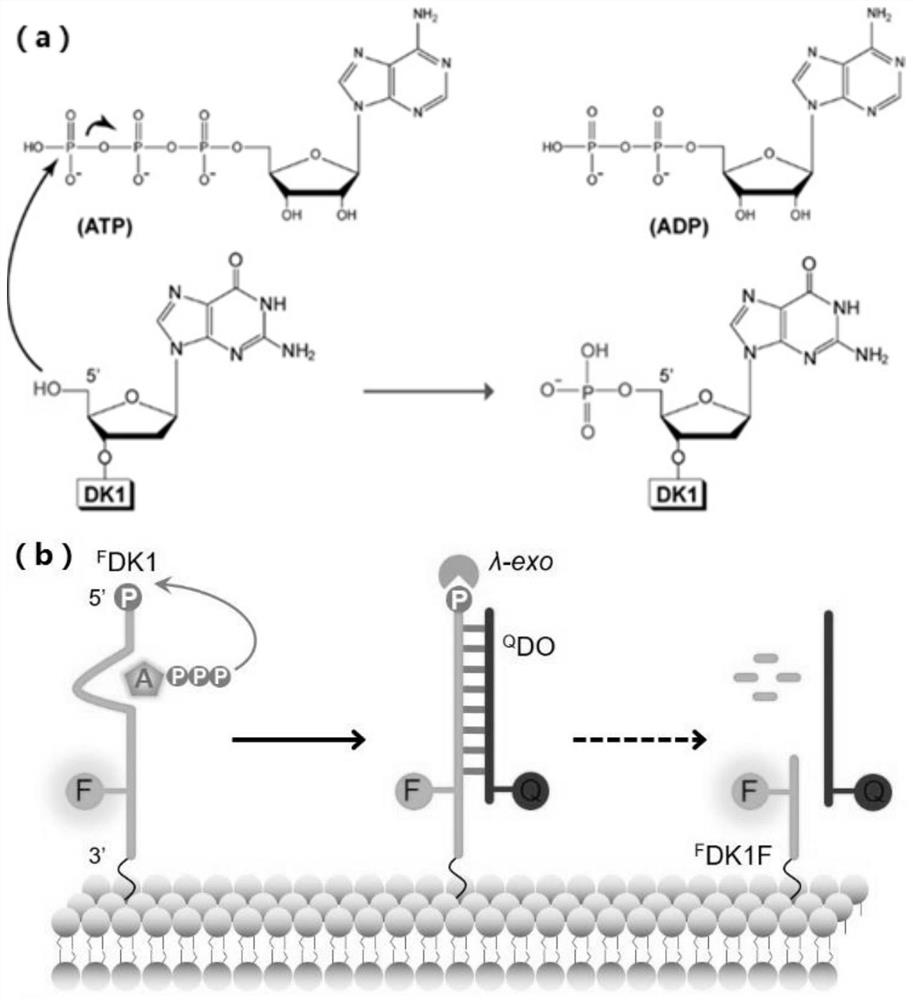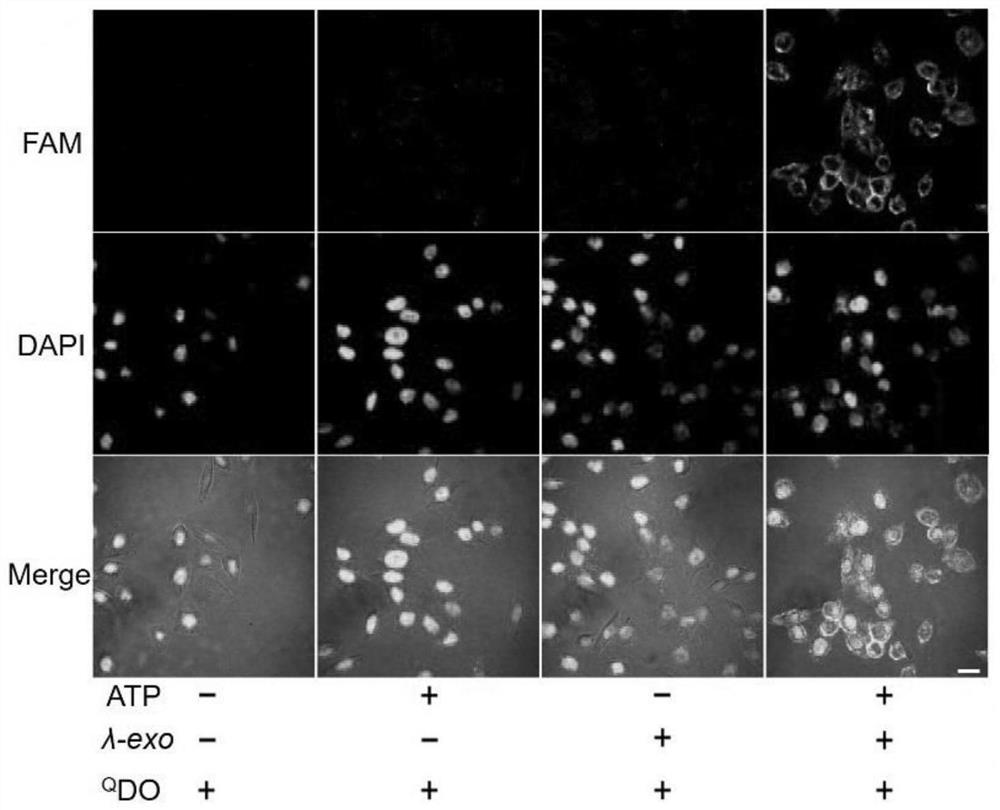A deoxyribozyme-based extracellular ATP rapid sensing method and application kit
A deoxyribozyme and sensing method technology, applied in the field of deoxyribozyme-based extracellular ATP rapid sensing method and application kit, can solve the problems of inability to guarantee the specificity of ATP detection, inability to distinguish ADP and AMP, and achieve Good specificity and accurate sensing results
- Summary
- Abstract
- Description
- Claims
- Application Information
AI Technical Summary
Problems solved by technology
Method used
Image
Examples
Embodiment 1
[0041] Embodiment 1 utilizes F DK1 molecules image MCF-7 cells
[0042] use F DK1 molecules image MCF-7 cells, the principle is as follows figure 1 As shown, the specific operation is as follows:
[0043] a) MCF-7 cell culture. Add 10% (v / v) fetal bovine serum (FBS), 100 U / mL penicillin and 100 μg / mL streptomycin to the modified DMEM medium, place at 37°C, 5% CO 2 and 95% air in a humid atmosphere. Before harvesting the cells, wash the cells with 1 mL of PBS, then add 1 mL of 0.25% (v / v) trypsin-EDTA solution (purchased from Invitrogen), and incubate at 37°C for 5 minutes to separate the cells from the culture dish to obtain Cell suspension, after the cell suspension was centrifuged at 3000g (5 minutes), the cells were resuspended in 1mL of DMEM, and approximately 1×10 5 The cells were transferred to glass-based culture dishes with a diameter of 35 mm and incubated at 37 °C for 24 h.
[0044] b) will F DK1 molecules are fixed on the surface of MCF-7 cell membrane. Tak...
Embodiment 2
[0046] Embodiment 2 utilizes F Confocal fluorescence imaging analysis of DK1 molecule on mouse brain astrocytes stimulated by glutamate
[0047] use F Confocal fluorescence imaging analysis of DK1 molecules on mouse brain astrocytes under glutamate stimulation, the steps are as follows:
[0048] a) Mouse brain astrocytes were obtained from pups of mice in the P1-P4 stage. Take the head of the mouse, peel the cortex of the mouse from the brain with flat-nose forceps under a microscope, carefully separate the cerebral hemisphere cortex from the cortex using fine forceps, mince the obtained cerebral hemisphere cortex, and place in a container containing 0.25 % (v / v) trypsin-EDTA culture medium for 10 minutes (37 ° C) to obtain mouse brain astrocytes. Seed the obtained cells in 25cm 2 Poly-L-lysine-coated culture flasks were cultured in DMEM medium containing 10% (v / v) fetal bovine serum (FBS), 100 U / mL penicillin and 100 μg / mL streptomycin , at 37°C, 5% CO 2 Cultured in a h...
Embodiment 3
[0054] Embodiment 3 utilizes F Confocal fluorescence imaging analysis of DK1 molecule on rat brain astrocytes under mechanical and electrical stimulation
[0055] useF Confocal fluorescence imaging analysis of DK1 molecules on rat brain astrocytes under mechanical and electrical stimulation, the steps are as follows:
[0056] a) Mouse brain astrocytes were obtained from pups of mice in the P1-P4 stage. Take the head of the mouse and peel the cortex of the mouse from the brain under a microscope using flat-nosed forceps, using fine forceps to carefully separate the hemispheric cortex from the cortex. The obtained cerebral hemisphere cortex was minced, placed in a medium containing 0.25% (v / v) trypsin-EDTA and incubated for 10 minutes (37° C.) to obtain mouse brain astrocytes. Seed the obtained cells in 25cm 2 Polylysine-coated culture flasks were cultured using DMEM medium, which contained 10% (v / v) fetal bovine serum (FBS), 100 U / mL penicillin and 100 μg / mL streptomycin, A...
PUM
 Login to View More
Login to View More Abstract
Description
Claims
Application Information
 Login to View More
Login to View More - R&D
- Intellectual Property
- Life Sciences
- Materials
- Tech Scout
- Unparalleled Data Quality
- Higher Quality Content
- 60% Fewer Hallucinations
Browse by: Latest US Patents, China's latest patents, Technical Efficacy Thesaurus, Application Domain, Technology Topic, Popular Technical Reports.
© 2025 PatSnap. All rights reserved.Legal|Privacy policy|Modern Slavery Act Transparency Statement|Sitemap|About US| Contact US: help@patsnap.com



